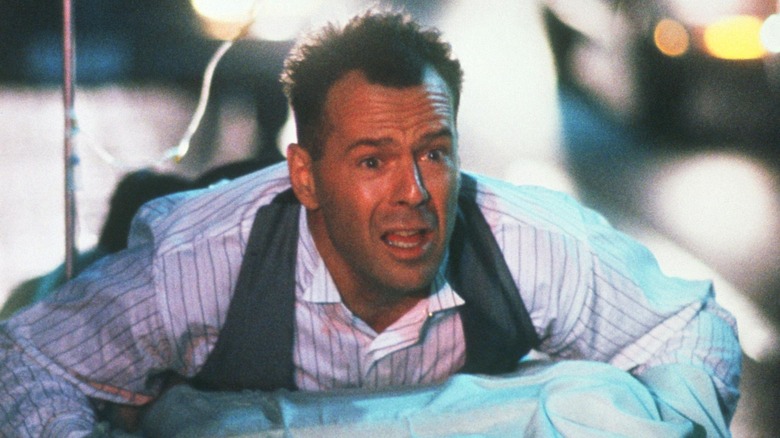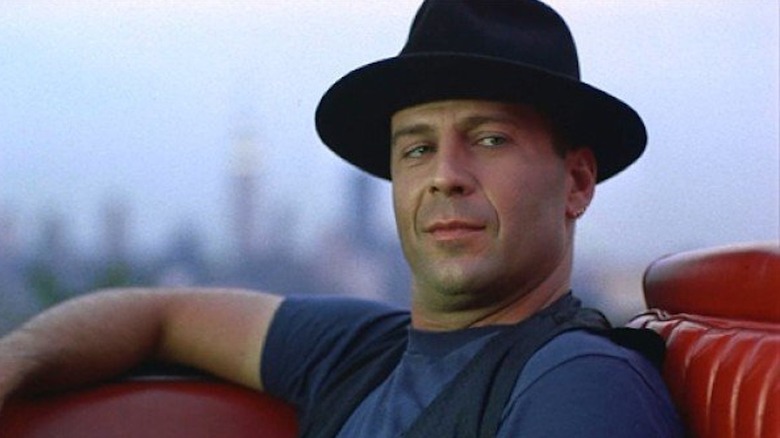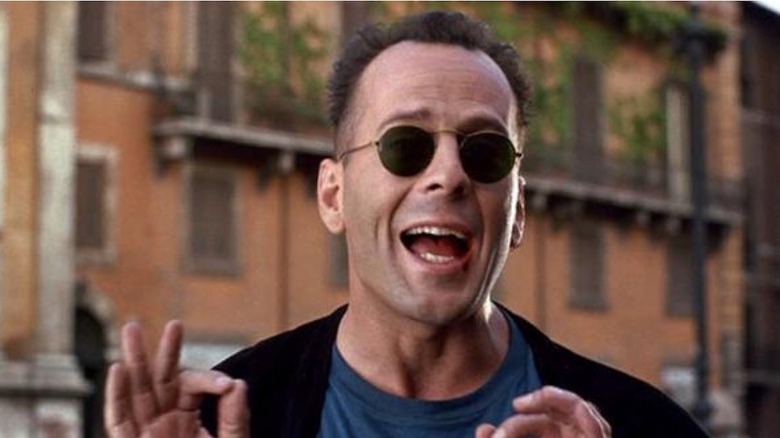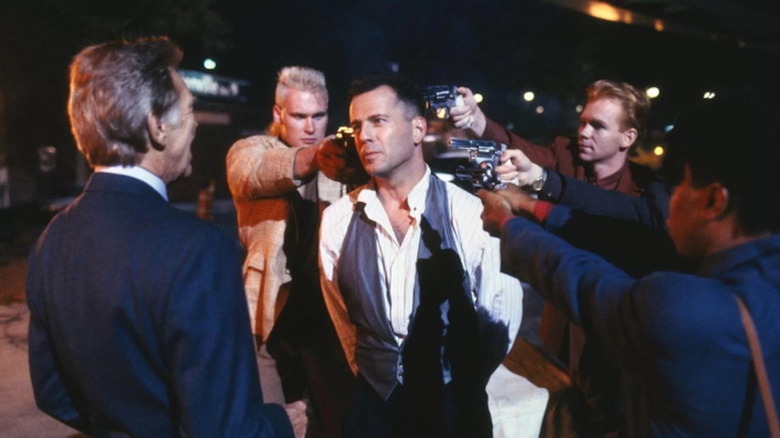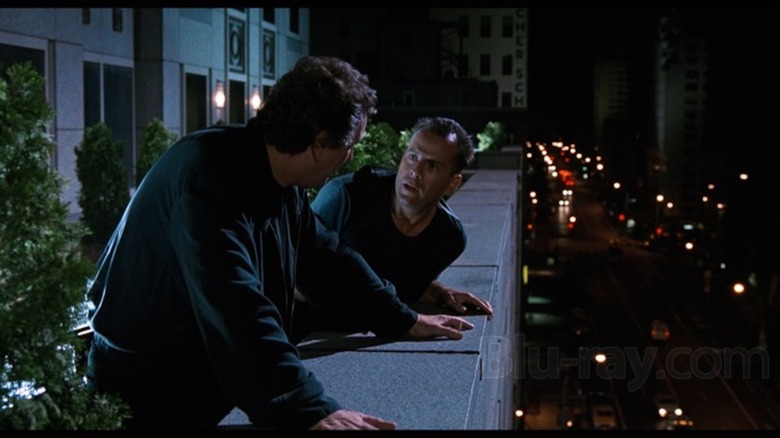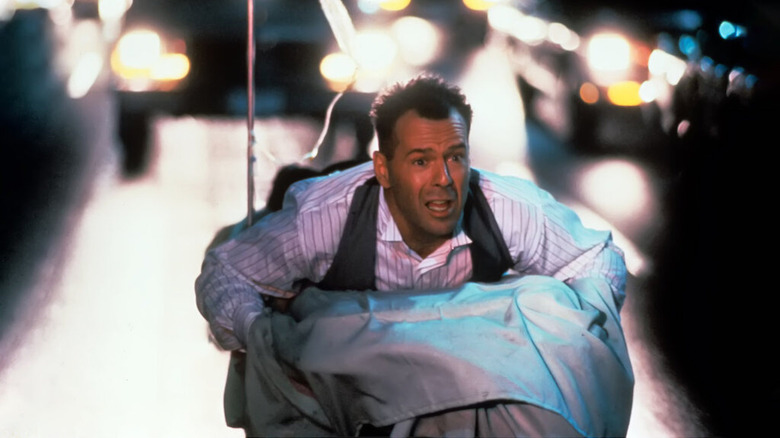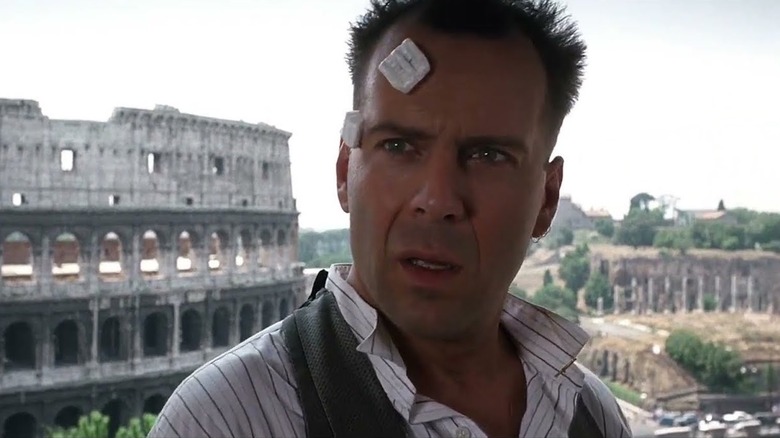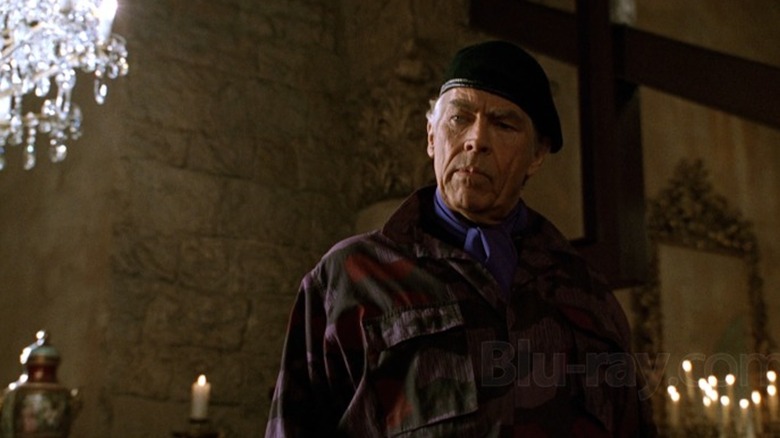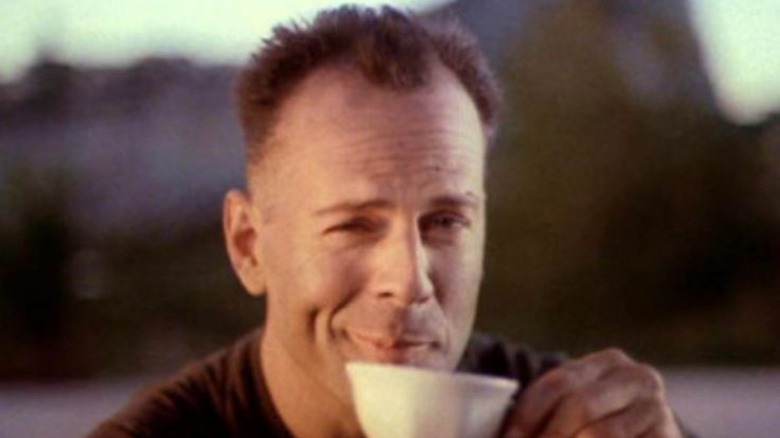The Misunderstood Box Office Flop That Nearly Ruined Bruce Willis' Career
In 1988, Bruce Willis committed a most grievous offense against entertainment journalists: he proved them wrong. Really wrong. Laughably wrong.
The newly minted star of ABC's "Moonlighting" drew the ire of just about everyone in Hollywood when 20th Century Fox paid him a whopping $5 million to star in the action film "Die Hard." This rankled rival studio executives, who only shelled out that kind of cash for long-established leading men like Warren Beatty and Robert Redford. While Willis might've been a minor media sensation due to "Moonlighting," with his surprise Billboard smash "The Return of Bruno" and his omnipresent Seagram's wine cooler commercials, he had yet to prove himself worthy of a $5 million big-screen payday.
Before "Die Hard," Willis had scored a solid theatrical hit with Blake Edwards' dismally unfunny "Blind Date." This was the extent of his motion picture oeuvre when Fox declared him a massive marquee name. Execs were right to be panicked. Paul Hogan's "Crocodile Dundee" came within $2 million of outgrossing "Top Gun" in 1986; when his sequel broke the blockbuster century mark two years later, Hogan could reasonably ask for north of $5 million on his next project. If Paramount didn't want its Down Under dynamo to bolt elsewhere, they'd have to meet his price.
The studios' only hope to avoid the Overpay Armageddon was for "Die Hard" to flop, which seemed probable. Reports of audiences howling at the sight of Willis blowing away bad guys broke through to mainstream outlets like Time and Newsweek — and, as an avid 15-year-old moviegoer at the time, I can confirm this really happened. Bruce Willis, action hero, was a big ol' no-sale. Also unhelpful: Willis' prickly relationship with the press. He bristled at the Barbara Walters-inspired celebrity profile format and let interviewers know he loathed the promotional process.
As the July 22, 1988 opening of "Die Hard" approached, it felt like most of Hollywood was rooting for Willis to faceplant. He'd get his comeuppance, but not before he scaled the A-list mountaintop. And then came the subject of this story: the infamous box office disaster "Hudson Hawk."
The road from everyman John McClane to crooning cat burglar Eddie Hudson Hawkins
"Die Hard" grossed $83 million domestically in 1988 and received mostly enthusiastic reviews. Willis was not just a bona fide movie star, he was the everyman action-hero antidote to the muscle-bound likes of Sylvester Stallone and Arnold Schwarzenegger. He'd refashioned an old Western archetype, allowing him to connect to viewers in a tangible manner that largely eluded the aforementioned hunks. And he was just plain funny. "Moonlighting" flamed out due to his big-screen stardom, but moviegoers lined up to see him provide the smartass voice for an infant in the surprise 1989 smash "Look Who's Talking."
Willis hit some choppy water in 1990 when "Look Who's Talking Too" underperformed, and Brian De Palma's pricey adaptation of "The Bonfire of the Vanities" outright tanked, but the former was viewed as a one-joke premise spread way too thin, while the miscast duo of Tom Hanks and Melanie Griffith — along with De Palma, who watered down the acerbic tone of the book — took the heat for the commercial/critical rejection of the latter. All that mattered for Willis career-wise was that "Die Hard 2" outperformed the original at the domestic and international box office. Critics were mixed on the sequel, but its "A" CinemaScore bolstered the star's everyman action-hero stature.
Had Willis played the press game with any degree of finesse, reporters might've lauded his willingness to take a wildly unlikable part in arthouse darling Alan Rudolph's "Mortal Thoughts." Rather than rake in another seven-figure payday in a mainstream action flick, he used his commercial cachet to promote inventive, off-center indie filmmakers.
The press might've also complimented his choice of Michael Lehmann, the director of 1989's dark comedy classic "Heathers," to helm his passion project "Hudson Hawk." Instead, sensing a hubristic disaster in the making, they unsheathed their knives and went in for the kill they'd been savoring since 1988.
Bruce Willis and Joel Silver were major Heathers fans
When Willis was living paycheck-to-paycheck as a bartender in New York City during the early 1980s, he hit upon the idea of a wily cat burglar character with his musician buddy Robert Kraft. Now that he could call his shot, Willis set the project up at TriStar with "Die Hard" series producer Joel Silver.
Tonally, Willis and Silver wanted something hip, yet silly, and they had their eyes set on the director-writer team of Michael Lehmann and screenwriter Daniel Waters, who'd wowed critics and cult filmgoers with the 1989 black comedy "Heathers." As Lehmann told me in a recent interview, "Joel Silver came to me rather aggressively through my agent, and he'd already been talking to Daniel Waters about working on some of his projects [e.g. the big-ticket action duo of "Demolition Man" and "The Adventures of Ford Fairlane"]." But Lehmann had other, more intellectually challenging projects on his mind. "There were a number of things I was pursuing," he said, "Including an attempt to option the rights to 'The Talented Mr. Ripley.' But I was also tied up finishing work on my second movie, 'Meet the Applegates,' so I had my hands full."
But Willis and Silver persisted, and Lehmann ultimately relented.
"There was plenty of general interest from the studios, and some decent material coming my way. But I wanted to do something unexpected with an unusual take. Bruce and Joel were big 'Heathers' fans, and expressed interest in having me do 'Hudson Hawk.' I met with and liked [Steven E. De Souza] ... but I was interested in taking a less conventional approach to the material and asked Dan Waters to get involved. Bruce and Joel were very much on board for that."
Hudson Hawk is an odd duck that broke critics' brains
That less conventional approach transformed what Tri-Star hoped would be a pre-sold 1991 summer blockbuster into an odd duck with as much in common with Alfred Hitchcock's "To Catch a Thief" as Theodore J. Flicker's 1967 counterculture romp "The President's Analyst" (also starring Coburn, whose 1960s spy spoofs inform the film's zany sensibilities as well). The basic premise of "Hudson Hawk" isn't that outlandish: recently paroled cat burglar Eddie "Hudson" Hawkins gets blackmailed by his sleazy parole officer, the Mario Brothers crime family, and the CIA to swipe a priceless piece of art from a prestigious Manhattan auction house. Danny Aiello plays Eddie's best pal/business partner/co-conspirator Tommy "Five-Tone" Messina, who talks him into the gig.
And here's where the film abandons its already sketchy real-world logic to become the big-budget action epic Frank Tashlin never got to make.
In the run-up to the first heist sequence, we notice that Tommy has a penchant for quizzing Eddie about the runtimes of pop songs. It seems like an extraneous bit of character-building detail until Eddie works out the desired duration of their theft. When Tommy gives him a ballpark figure, Eddie locks in on Bing Crosby's "Swinging on a Star." Next thing we know, we're watching Willis and Aiello croon the standard as they evade security to extract the goods. This sequence broke most critics' brains (a veteran journo told me their press screening devolved into groans, and the film never recovered).
The moment you either buy in or check out of Hudson Hawk
One of the knocks on the set piece is that neither Willis nor Aiello can do more than barely carry a tune. This is nonsense because a) Willis does above-average work on "The Return of Bruno," while Aiello knocks out a lovely interpretation of "Fly Me to the Moon" in Lasse Hallström's underrated "Once Around," and b) They're in the midst of a carefully planned heist, so functionality trumps quality and c) They're timing a heist to a Bing Crosby standard!
A few minutes later, Eddie is forced to jump off the ledge of a building onto its first-floor awning, at which point Lehmann cuts to Willis landing on a BarcaLounger in the chintzily decorated living room of his parole officer (who, within a minute of Eddie's arrival, gets his throat slashed by a henchman carrying retractable blades in his suit sleeves).
This is the moment you either buy in or shut the film off because Lehmann's film never eases up on the absurdity or the budgetary extravagance — which, to me, is an utter delight because a) It's not my freakin' money financing these series of shockingly expensive set pieces, and b) We don't see this kind of non-CG-enhanced studio spectacle anymore.
Hudson Hawk turned the Brooklyn Bridge into a war zone during filming
This got Lehmann in trouble on more than one occasion. One of the most notorious challenges facing the production was the filming of the Brooklyn Bridge set piece wherein Willis, having been whisked off by the Mario Brothers in an ambulance, executes a grisly escape and finds himself being dragged behind the vehicle on a gurney (á la Jerry Lewis in "The Disorderly Orderly" — yet another tipoff to the critics that this is not Michael Mann's "Thief"). The shoot lasted five days so the production could string fluorescent lights across the entire bridge. This made the heavily trafficked throughway inaccessible for the better part of the week. According to Lehmann, their prolonged presence turned the bridge into, literally, a bit of a war zone:
"This did not make commuters and residents of Brooklyn very happy. When we were doing the actual shooting, I was told that a sniper was shooting at us from the Brooklyn side, but as far as I know, none of the shots came particularly close, and certainly no one was hit. I myself never heard gunfire or had to take cover, but we were on our toes and cautious for the rest of our time on the bridge."
Michael Lehmann considered quitting Hudson Hawk mid-production
Upon completing the Brooklyn Bridge sequence, Lehmann still had to watch his back. As the original $42 million budget breached $50 million (and, according to a 1991 New York Times piece, climbed a good deal higher), TriStar began keeping close tabs on the production. When the company's head honcho, Mike Medavoy, visited the set during its rather expensive stay in Rome (where, shall we say, unusual financial arrangements had to be made with the local authorities), he warned Lehmann that if "Hudson Hawk" bombed, the director would never work again. Lehmann, realizing the film was by no means a slam-dunk blockbuster, desperately looked for an exit:
"I asked my agent, essentially, 'Who do I have to f*** to get off this movie?' He said that there was no positive value to quitting and encouraged me to hang in. I'd never quit anything in my life, so I'm not sure how serious I was about leaving, but I was considering it. A friend of mine suggested I talk to [Jim] McBride [ed note: director of the brilliant documentary satire 'David Holzman's Diary' and the wildly underappreciated 'Breathless' remake]. Jim had quit a movie years before, and he said he regretted it because of the damage it did to his career and the difficulty he had in getting projects off the ground after that. So I stayed on board and kept fighting to make the movie I wanted."
The ballad of Hudson Hawk's monkey sidekick, Little Eddie
Lehmann hung in there, as did Waters, and they did their best to maintain that zany, overproduced tone while accommodating a star/producer who occasionally made some difficult, if not entirely unworkable suggestions. Willis' most bizarre idea involved giving his protagonist a monkey sidekick named "Little Eddie." Lehmann wasn't yet a veteran director, but he knew working with animals was the last thing an over-budget vanity production needed.
Eventually, a compromise was reached. Waters concocted a backstory that involved Coburn's nefarious CIA operative George Kaplan — not the film's only Hitchcock reference, but easily its best — having killed Little Eddie for some reason or another. During their climactic fight at Leonardo da Vinci's castle, as Eddie believes he's about to deliver the coup de grace to Kaplan, he somehow tapes a picture of Little Eddie to Kaplan's forehead. So next time you watch "Hudson Hawk," pause the film as Kaplan hits the hood of the Mayflowers' limousine. It's dark, but you'll be able to see, in close-up, a picture of Little Eddie taped to Kaplan's forehead.
Hudson Hawk turned a profit despite flopping at the box office
33 years after its release, "Hudson Hawk" is occasionally cited as one of the most notorious bombs in Hollywood history. It's not. According to legendary Variety columnist Army Archerd, "Hudson Hawk" was in the black by 1995. That's a remarkable accomplishment for a $50 million-plus production that grossed $17 million domestically, and it's possible Archerd was carrying a bit of water for Silver there (the man's career hinged on trading favors), but like a sprinkler system in the back of a limo, I can f***ing believe it.
In retrospect, TriStar should've probably avoided a crowded Memorial Day weekend led by Ron Howard's "Backdraft" (which hit most of the same quadrants as "Hudson Hawk"), but this was also at the conclusion of a months-long press campaign during which one Chicago Tribune journo, sight unseen, called the film "the last of a dying breed: the super-expensive summer movie." If you were a regular moviegoer during the summer of 1991, you might remember the July 3 release of what was then the most expensive movie ever made, "Terminator 2: Judgment Day." Given the state of the industry today, that might be the most hilariously inaccurate prediction ever made by an entertainment reporter.
As for Lehmann, he survived another box office disappointment (the cult favorite "Airheads") before scoring a bona-fide hit with the lovely 1996 romantic comedy "The Truth About Cats & Dogs." Meanwhile, Willis continued to champion talented young filmmakers, often evincing a sharp eye for ambitious material (e.g. "Pulp Fiction," "The Sixth Sense," and "Looper"). He also kept his action-hungry fans happy until he was forced to retire in 2022 due to the mental disorder aphasia (he has also been diagnosed with frontotemporal dementia) — 36 years after he allegedly bankrupted Hollywood with his $5 million deal for "Die Hard."
And 33 years after he had us all swinging on a star with "Hudson Hawk." What a miraculous run. I just hope Captain Bob's steering wheel is in good hands.
